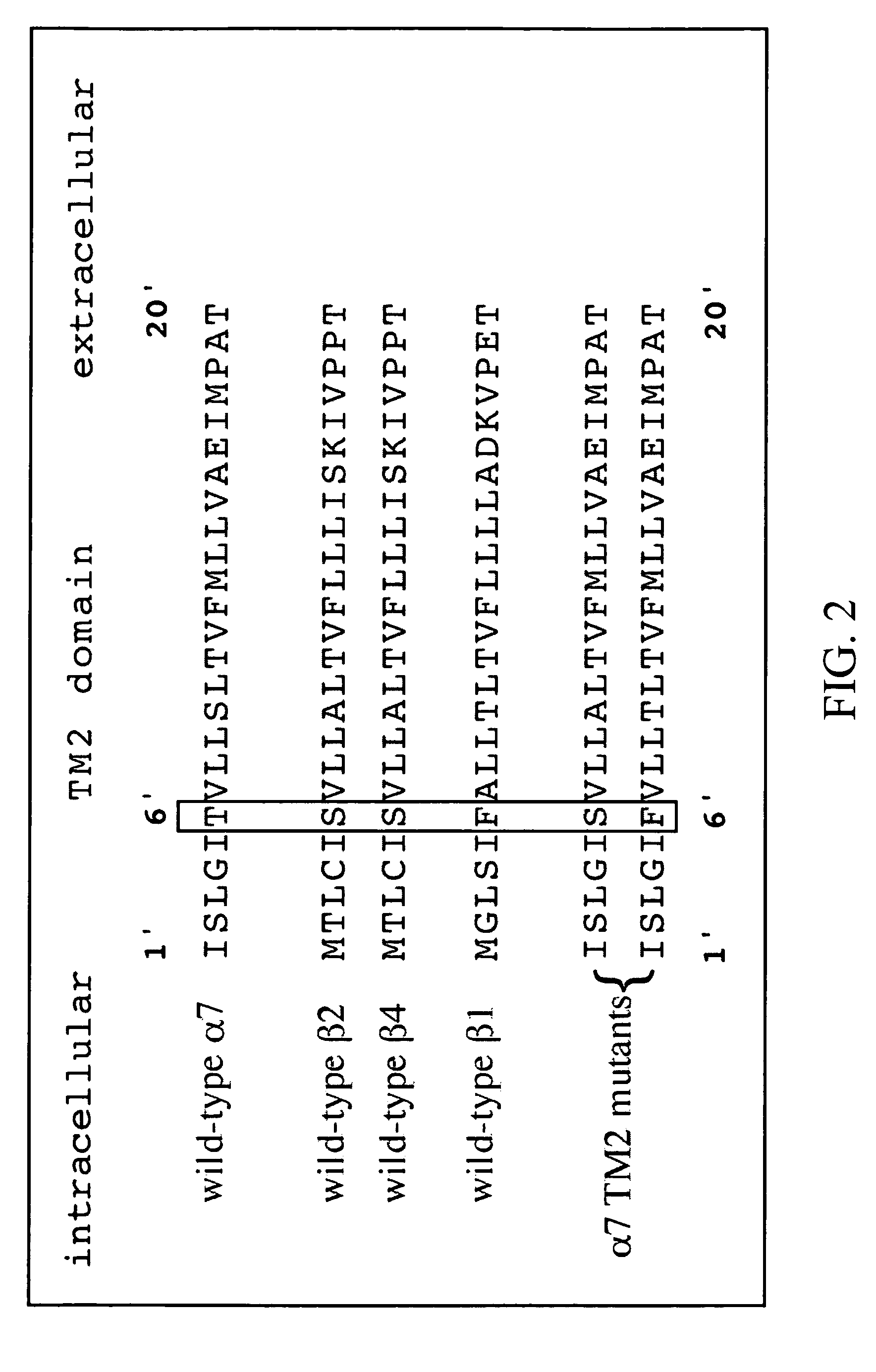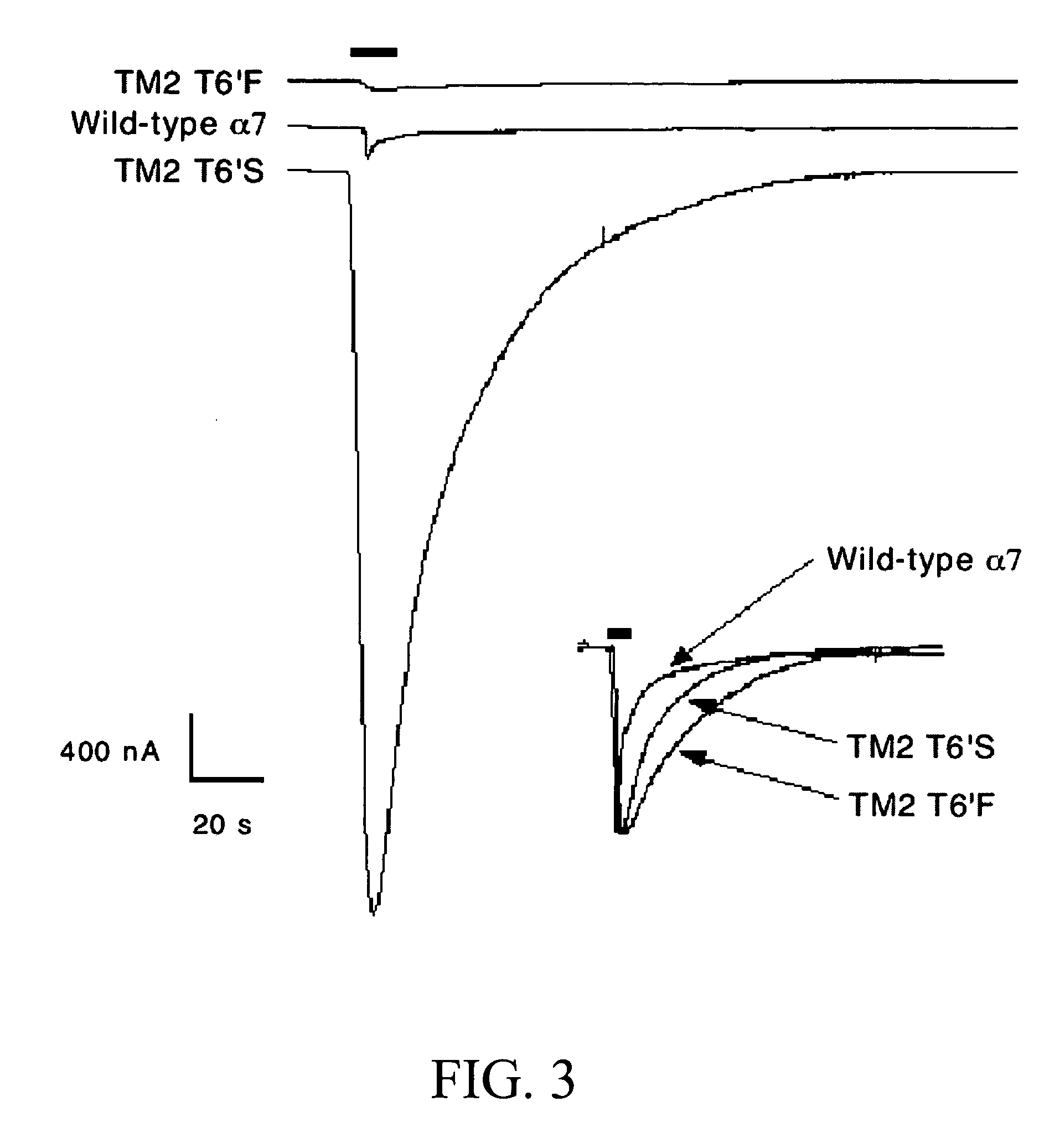Variant neuronal nicotinic alpha-7 receptor and methods of use
a technology of nicotinic alpha-7 and neuronal nicotinic alpha-7, which is applied in the field of variable neuronal nicotinic alpha-7 receptor and methods of use, can solve the problems of difficult study with large-scale drug screen, impede the development of drugs targeting the 7 receptor therapeutically, etc., and achieve the effect of reducing the desensitization ra
- Summary
- Abstract
- Description
- Claims
- Application Information
AI Technical Summary
Benefits of technology
Problems solved by technology
Method used
Image
Examples
example 1
The T6′S Mutant Receptor Pharmacology Closely Resembles That of Wild-Type α7
[0229] Raw data traces from transiently transfected GH4Cl cells show the larger amplitude and slower macroscopic kinetics of the T6′S mutant compared to wild-type α7 (FIGS. 8A and 8B), and that this observation carries over from oocyte studies to a mammalian cell under whole-cell voltage clamp. Table 2 shows the results of oocyte experiments examining representative concentrations of a battery of compounds, indicating the ability of the T6′S mutant to effectively emulate wild-type α7. For the drugs examined, the T6′S mutant is more like wild-type α7, particularly in regard to antagonists that have been converted to agonists in the L247T mutant.
[0230]FIGS. 8A and 8B and Table 2 show that the T6′S variant of the present invention yields much larger currents than wild-type α7 receptor, and provides a more faithful representation of the wild-type α7 pharmacology than does the commonly used L247T mutant.
TABLE...
example 2
Alpha7 TM2 6′ Mutants are Functionally Expressed in Oocvtes and Impact Absolute Current Amplitude
[0231] Raw data traces for each of the TM2 6′ single point mutations and wild-type α7 are shown in FIG. 3. A particularly obvious difference between the two 6′ mutant receptors and wild-type α7 is the consistently large peak current for the T6′S mutant and the relatively small peak for the T6° F. response. Quantification of differences in absolute amplitude is complicated by variations in the degree of receptor expression from cell to cell (which is why each cell is used as it's own control), however variations in current amplitude similar to those seen were regularly observed.
example 3
The α7 T6′F Mutation Increases ACh Potency While the T6′S Mutant Shows no Significant Change in ACh Potency Compared to Wild Type α7
[0232] Concentration-response functions for wild-type α7 and each of the two TM2 6′ mutants are seen in FIGS. 4A-4C. Both net charge (area under the curve) and peak CRCs are shown to illustrate the differences in apparent ACh potency as a function of the analysis method used. Comparison of these analyses shows that the wild-type α7 receptor shows the greatest difference in apparent potency, while the two 6′ mutants show less difference between the two methods, probably due to their slower response kinetics (see methods). In addition, a dramatic increase in ACh potency is seen for the net charge analysis if the T6′F mutant, whereas the T6′S mutant is not significantly different from wild-type.
PUM
| Property | Measurement | Unit |
|---|---|---|
| wt. % | aaaaa | aaaaa |
| melting temperature | aaaaa | aaaaa |
| Tm | aaaaa | aaaaa |
Abstract
Description
Claims
Application Information
 Login to View More
Login to View More - R&D
- Intellectual Property
- Life Sciences
- Materials
- Tech Scout
- Unparalleled Data Quality
- Higher Quality Content
- 60% Fewer Hallucinations
Browse by: Latest US Patents, China's latest patents, Technical Efficacy Thesaurus, Application Domain, Technology Topic, Popular Technical Reports.
© 2025 PatSnap. All rights reserved.Legal|Privacy policy|Modern Slavery Act Transparency Statement|Sitemap|About US| Contact US: help@patsnap.com



